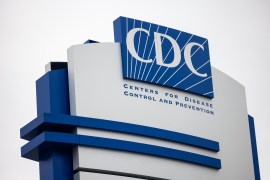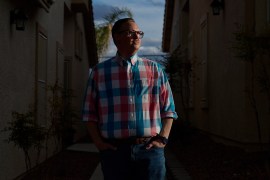‘We Never Give Up’: When Illnesses Are Mystifying, Researchers In The Undiagnosed Disease Network Look For Answers
Doctors in 12 clinical centers pull out all the stops to try to find a diagnosis and treatment for thousands of patients looking for miracles. Public health news also focuses on a mosquito-borne virus worse than Zika; the Dunning-Kruger effect; the poor's smoking rates; race and Alzheimer's disease; stroke risk; the birth of a podcast; the future of newborn DNA testing; what it's like to have nut-allergies; the upside of breakups; and good news about braces.
The New York Times:
When The Illness Is A Mystery, Patients Turn To These Detectives
They are patients with diseases that mystify doctors, people whose symptoms are dismissed as psychosomatic, who have been given misdiagnosis upon misdiagnosis. They have confounded experts and have exhausted every hope save one. And so they wind up in the Undiagnosed Diseases Network, a federally funded project that now includes 12 clinical centers, including one at the National Institutes of Health in Bethesda, Md. (Kolata, 1/7)
The New York Times:
A Virus Even More Dangerous Than Zika To Pregnant Woman
The mosquito-borne virus that causes Rift Valley fever may severely injure human fetuses if contracted by mothers during pregnancy, according to new research. In a study published last month in the journal Science Advances, researchers used infected rats and human fetal tissue to discover how the virus targets the placenta. Results showed that the virus may be even more damaging to fetuses than the Zika virus, which set off a global crisis in 2015 and left thousands of babies in Central America and South America with severe birth defects. (Baumgaertner, 1/7)
The Washington Post:
What’s Behind The Confidence Of The Incompetent? This Suddenly Popular Psychological Phenomenon.
You may have witnessed this scene at work, while socializing with friends or over a holiday dinner with extended family: Someone who has very little knowledge in a subject claims to know a lot. That person might even boast about being an expert. This phenomenon has a name: the Dunning-Kruger effect. It’s not a disease, syndrome or mental illness; it is present in everybody to some extent, and it’s been around as long as human cognition, though only recently has it been studied and documented in social psychology. (Fritz, 1/7)
Los Angeles Times:
Smoking Is At A Record Low In The U.S., But The Benefits Aren't Shared Equally
Cigarette smoking is at an all-time low in the United States, but the benefits of this public health achievement are not being shared equally by all Americans. A new analysis of health data from the nation’s 500 largest cities shows that the people who live in neighborhoods with the highest smoking rates are more likely to be poor, less likely to be white, and more likely to have chronic heart or lung diseases. (Kaplan, 1/7)
NPR:
Study Offers Clues To Racial Differences In Alzheimer's Disease
Scientists have found a biological clue that could help explain why African-Americans appear to be more vulnerable than white Americans to Alzheimer's disease. A study of 1,255 people, both black and white, found that cerebrospinal fluid from African-Americans tended to contain lower levels of a substance associated with Alzheimer's, researchers report Monday in the journal JAMA Neurology. Yet these low levels did not seem to protect black participants from the disease. (Hamilton, 1/7)
The Washington Post:
Men’s Cardiorespiratory Fitness Affects Stroke Risk, Researchers Say
Low fitness levels have long been tied to higher risk for heart problems. Now researchers say men’s cardiorespiratory fitness is tied to their risk for stroke, as well. Researchers in Norway followed 2,014 middle-aged men for more than 20 years. Those who were unfit for the whole study period, or who started out fit but became less so, were twice as likely to have a stroke as those who stayed fit or became fit, they reported in the International Journal of Stroke. (Crist, 1/7)
NPR:
Parenting Podcast And New Book By Hillary Frank Started With A Difficult Delivery
Almost 10 years ago, journalist Hillary Frank was pregnant and planning to give birth without medication or surgery — but things didn't go according to her plan. Instead, Frank experienced a prolonged and difficult labor that left her with a traumatic injury — chronic pain from an episiotomy that didn't heal as expected, and had to be redone. For months she was unable to walk, sit or easily hold or nurse her newborn daughter, and didn't fully recover for three years. To make matters worse, beyond the physical injury, she felt she couldn't talk openly about what had happened to her. (Gross, 1/7)
CNN:
Newborn DNA Testing: Could It Become Routine?
Every baby born in the United States is given a routine blood test to screen for dozens of inherited medical conditions. Now, the U.S. National Institutes of Health is exploring whether to use DNA sequencing to screen newborn babies for additional genetic abnormalities and disorders. Such DNA testing would likely complement, but not replace, the current routine blood tests. However, before routine genetic screening of infants even approaches reality, many questions need answers, including whether genetic sequencing can accurately identify babies who will develop a disease, according to Dr. Joseph A. Bocchini Jr., chairman of the Advisory Committee on Heritable Disorders in Newborns and Children. (Scutti, 1/7)
Kaiser Health News:
Will I Always Face The Threat Of A Peanut-Laden Kiss Of Death?
Whenever I see a report touting possible new peanut allergy treatments, I devour it. I can’t help it. It’s an occupational hazard for any health journalist whose reporting specialty and medical history intertwine. I write about the business of health care, focusing on how consumers interact with the system — what we pay, what we get and why American care costs so much. But in this particular instance, I have another kind of authority: 26 years of life-threatening allergies to nuts and peanuts. (Luthra, 1/8)
The Wall Street Journal:
How A Breakup Can Lead To A Fitness Breakthrough
Paige Harley couldn’t have guessed that the path to recovery from the end of her second marriage would lead to the South Pole. The 49-year-old mother of three from Nashville, Tenn., turned to running as a form of therapy in 2016, as she had after her first divorce. “I didn’t know who I was outside a relationship. Running set me up to learn what I could do,” says Ms. Harley, a mediator who helps families going through divorce. Then she read an article about doing a marathon on all seven continents. “It was about facing my fears. Do I like to travel? Do I like to do hard things?” (Potkewitz, 1/7)
The New York Times:
No More Brace Face? Teens Increasingly Use Clear Aligners
When Carly Feinstein was in ninth grade, her dentist sent her to an orthodontist. “I cried for three hours when I heard I had to get braces,” said Carly, now 16, who lives in New York City. “I worried about how I would look. It would have been so embarrassing.” But like an increasing number of adolescents, she was delighted to learn that she did not need to get traditional metal braces after all. She was treated with clear aligners instead. (Harris, 1/8)






